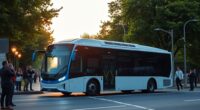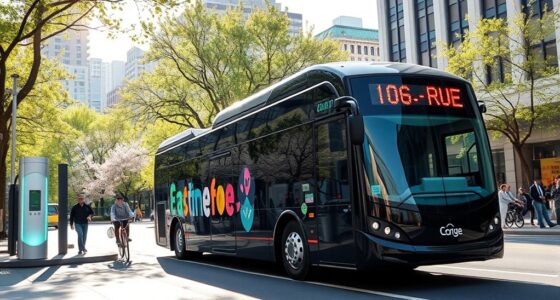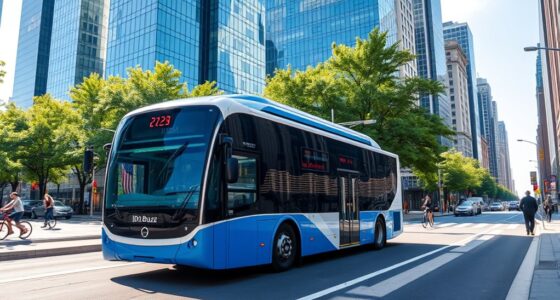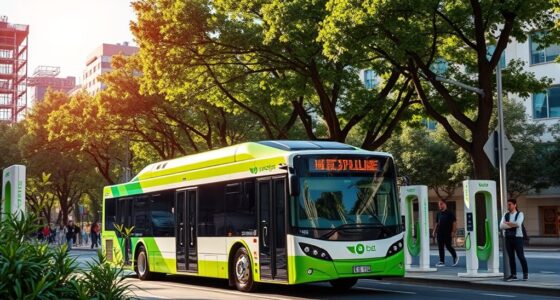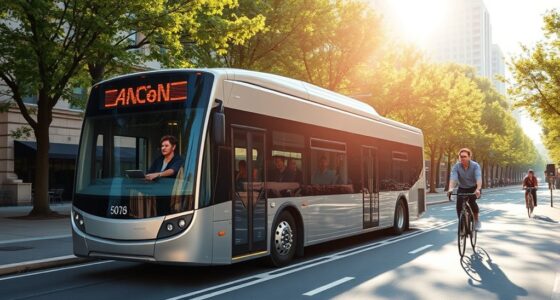Electric buses generally have a lower water footprint than diesel buses, especially when powered by renewable energy sources like wind and solar. Diesel buses require water for fuel extraction and refining, adding to their overall impact. In contrast, electric buses depend on electricity, which can be produced with minimal water use when generated renewably. Understanding regional water availability and policies can further influence their impacts—continue to explore how these factors shape sustainable transportation options.
Key Takeaways
- Electric buses typically have a lower overall water footprint than diesel buses, especially when powered by renewable energy sources.
- The water footprint of electric buses depends heavily on the electricity grid’s fuel mix, with cleaner grids reducing water use.
- Diesel buses indirectly consume water through fuel extraction and refining processes, adding to their total water footprint.
- Renewable electricity generation (solar, wind) for charging electric buses uses minimal water compared to fossil fuel power plants.
- Regional water availability and policies influence the water footprint of both electric and diesel buses, impacting their environmental benefits.
Understanding Water Use in Transportation Options
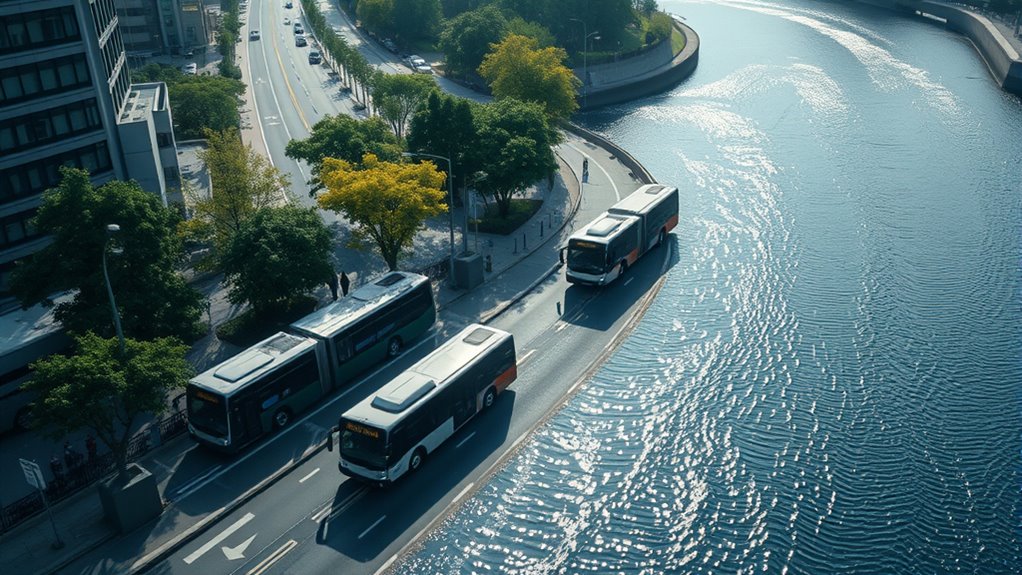
Understanding water use in transportation options is essential because different modes consume water in distinct ways. When you choose public transit or cycle, you substantially reduce water footprints by cutting down on gasoline consumption. Additionally, the manufacturing and maintenance of transportation infrastructure, such as roads and charging stations, also contribute to water use in the supply chain. Calculating water footprints involves considering both direct water use and how energy is produced—some methods, like hydroelectric power, can introduce considerable evaporative water losses. Regional variations also matter; areas relying on water-intensive energy sources will have higher transportation water footprints. For example, electric buses generally use less water than diesel buses because they rely on electricity, which can be generated from low-water sources. Even the infrastructure, like charging stations, can require water for construction and maintenance. Understanding these differences helps you grasp the overall impact of your transportation choices on water resources, especially when considering the energy production methods. Moreover, the water footprint of electric buses can vary depending on the efficiency of the battery manufacturing process, which influences overall water consumption. Additionally, advancements in clean energy technologies are expected to further reduce water use in electric transportation systems.
Water Consumption in Biofuel Production Versus Electric Power
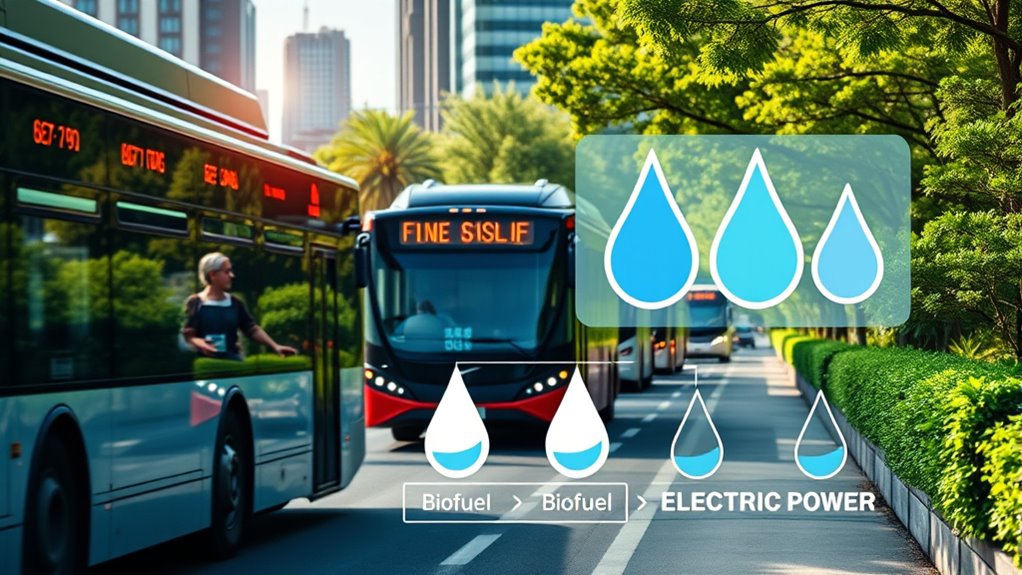
Biofuel production and electric power generation differ markedly in their water demands, shaping their environmental impacts. Producing biodiesel from soybeans requires over 11,000 liters of water per liter, mainly from crop irrigation, which stresses water resources and competes with agriculture.
Bioethanol from sugar beets uses around 1,200 liters per liter, with additional water needed during conversion—about 2 to 4 gallons per gallon of ethanol.
In contrast, renewable electricity sources like solar and wind need minimal water, mostly for cleaning and cooling, while hydroelectric power depends on water flow.
Thermal power plants, however, consume large quantities of water for cooling, often exceeding biofuel water use. Water consumption in power generation varies widely depending on the technology and location, influencing environmental sustainability.
Comparing Water Footprint of Electric and Diesel Buses
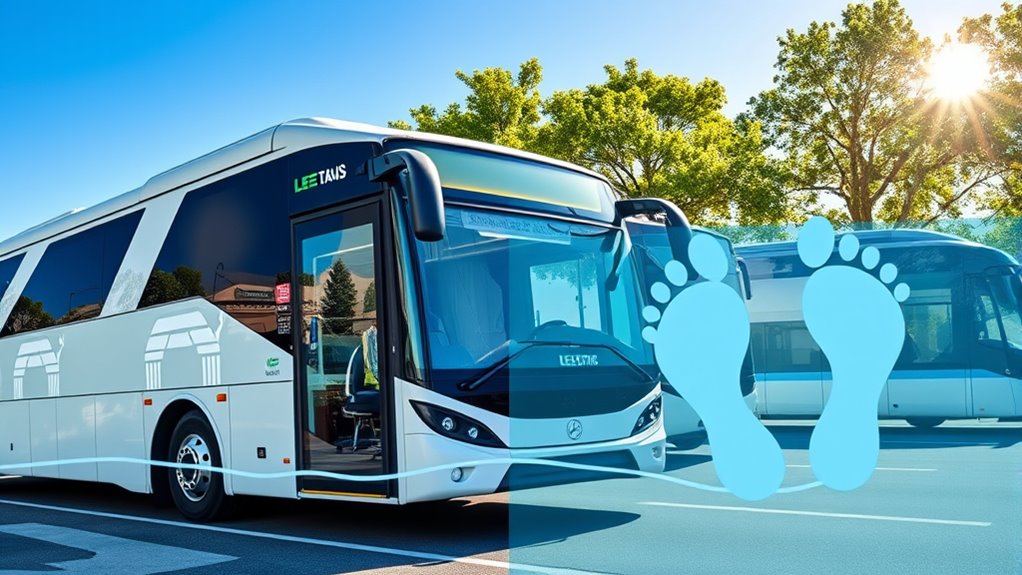
When comparing the water footprint of electric and diesel buses, it’s important to take into account how their fuel sources and operational processes influence water use. Diesel buses rely on fossil fuels, which require water for extraction and refining, adding to their indirect water footprint. Proper planning can help mitigate these impacts and improve overall sustainability. Electric buses depend on electricity, whose water use varies based on generation methods. Hydroelectric power, for example, has a high water footprint, while solar and wind are much less water-intensive. Electric buses are more energy-efficient, converting about 60-70% of electricity into motion, compared to only 20% for diesel. Although electric buses eliminate local water pollution, their overall water footprint depends on the electricity grid’s fuel mix. Additionally, advancements in Hyundai Tuning have led to more efficient vehicle systems that can reduce overall energy consumption. The water use associated with electricity generation also plays a crucial role in determining the total water footprint of electric buses. Considering the lifecycle environmental impacts of these vehicles helps provide a comprehensive view of their sustainability. Therefore, electric buses can have a lower water footprint, especially when powered by renewable energy sources.
Regional Factors Influencing Water Usage in Bus Fleets
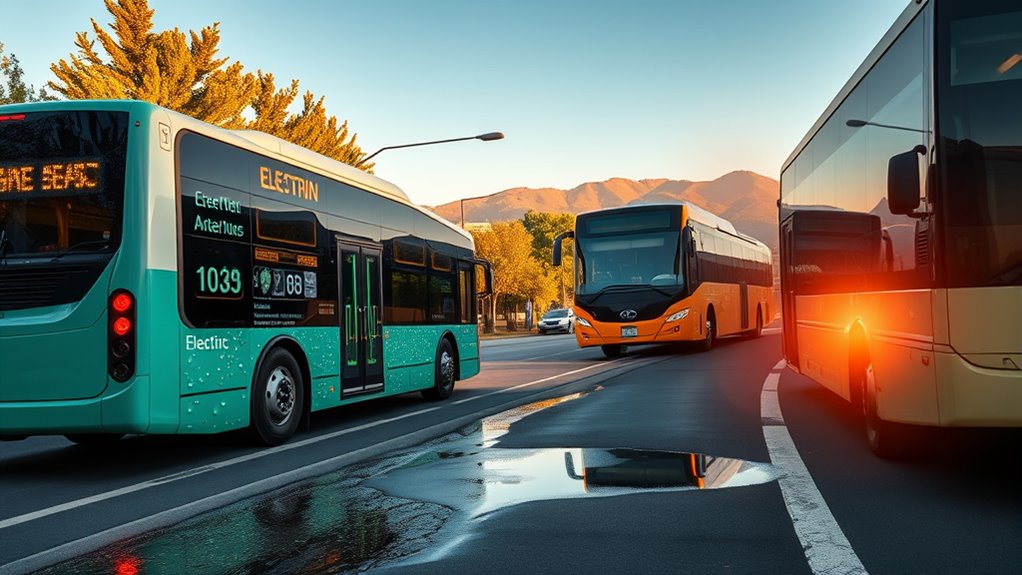
Regional water availability markedly influences how bus fleets impact local water resources. In areas with low water availability, maintaining fleets becomes more costly and challenging, especially in inland regions where fresh water is scarce. A new sentence with sustainable design and the rest of the sentence. Seasonal variations, such as droughts, can further increase water demand for washing and maintenance. Urban areas often have different water management systems than rural regions, affecting water usage patterns. Water conservation policies play a critical role in promoting efficient practices, reducing overall water consumption. Infrastructure factors, like service facilities and fueling stations, also shape water use. Additionally, temperature, humidity, and extreme weather events influence maintenance routines and cooling needs, impacting water demand. Regional water pricing and regulations can either incentivize conservation or increase operational costs, shaping how fleets adapt to local conditions. Water management systems can significantly influence the efficiency of water use in different regions, especially when combined with efficient maintenance practices. Incorporating regional water policies into fleet planning can further optimize water usage and sustainability.
The Role of Renewable Energy in Reducing Water Impact
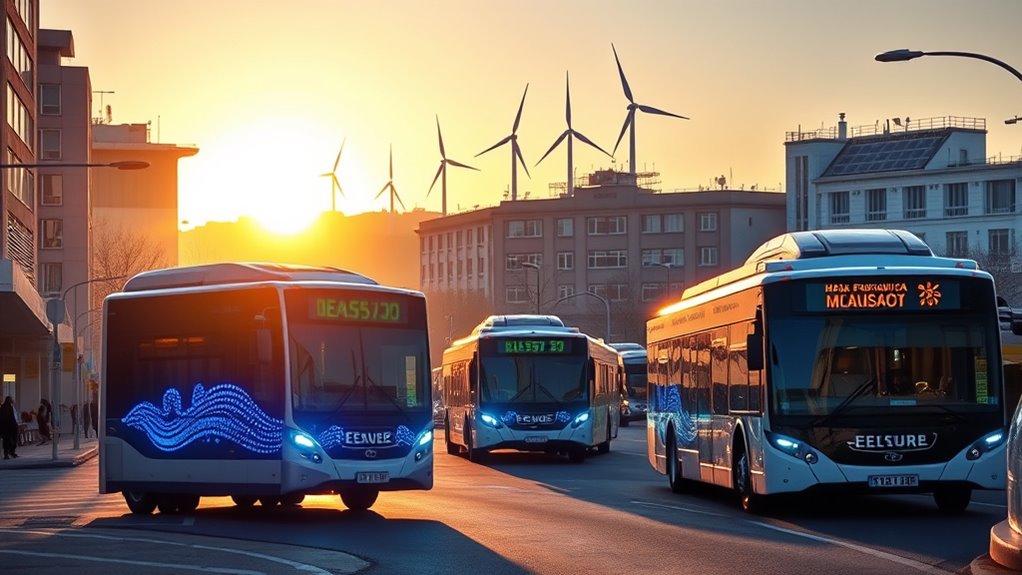
Renewable energy sources like solar and wind considerably reduce water impacts in bus operations by requiring minimal water for electricity generation. Unlike fossil fuel plants, renewables avoid large water consumption for cooling and steam processes, notably lowering water use. Solar photovoltaic and wind farms operate with little to no water, and when integrated at bus depots, they reduce dependency on water-intensive grid power. Producing green hydrogen through electrolysis powered by renewables also cuts water use compared to traditional methods. Additionally, renewable microgrids enable buses to charge on-site, decreasing the need for water-heavy centralized power plants. Implementing renewable energy integration strategies further enhances water conservation efforts in transportation infrastructure. Promoting water-efficient technologies in renewable systems helps further reduce water footprints. This shift also supports sustainable resource management, which is essential for long-term environmental health. By shifting to renewables, you help decrease water pollution linked to fossil fuel extraction, refining, and transportation, making bus operations more sustainable and water-conscious.
Economic and Environmental Benefits of Electric Buses
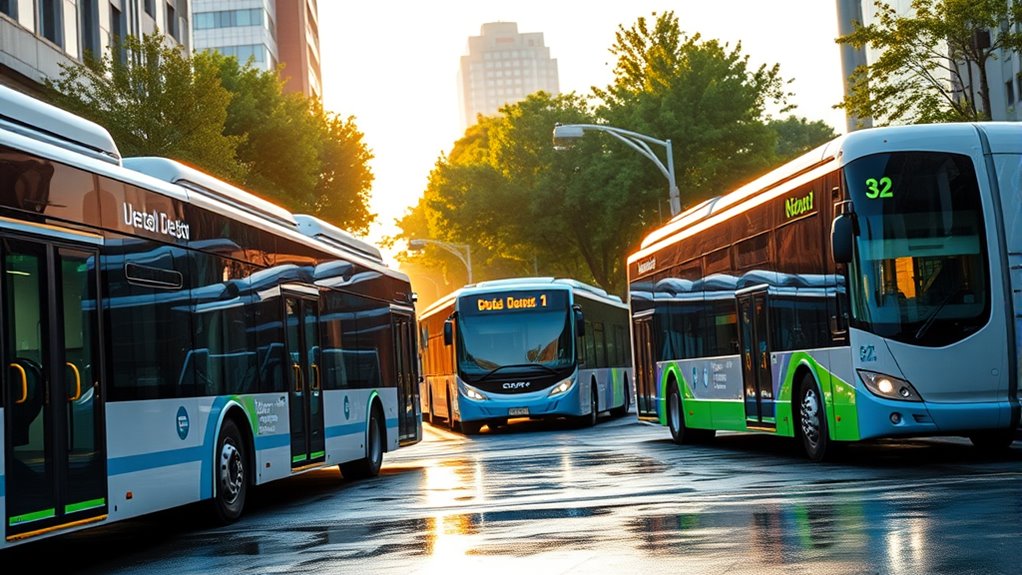
Electric buses offer compelling economic and environmental advantages that make them a smart choice for sustainable transportation. They cost about 2.5 times less to operate than diesel buses, thanks to lower electricity prices, and are over five times more energy efficient.
Although their upfront costs are higher—three to five times that of diesel buses—long-term savings on maintenance and fuel often outweigh initial expenses, especially with incentives. Production quantity variance can be minimized with proper planning, further improving their cost-effectiveness over time. Implementing scalable manufacturing strategies can help reduce costs and meet increasing demand.
Environmentally, electric buses drastically reduce greenhouse gas emissions, improving air quality and offering up to $247,600 in health benefits per bus. They can run on renewable energy, further lowering their carbon footprint. Furthermore, adopting electric buses contributes to reducing dependence on fossil fuels, which enhances energy security and sustainability.
Additionally, electric buses operate quietly, reduce noise pollution, and require less maintenance, making them a sustainable, efficient, and healthier transportation option. Maintenance benefits are also significant, as electric motors have fewer moving parts, reducing breakdowns and repair costs over time.
Policy Trends and Future Directions for Sustainable Transit

Despite ongoing regulatory uncertainties, the transportation industry continues to shift toward sustainable fleet technologies, driven by strong policy support at various government levels. Federal funding pauses, like those from executive orders, may slow projects, but state and local governments still allocate over $13.5 billion to zero-emission vehicle initiatives.
Emissions regulations and compliance questions create some turbulence, yet initiatives like the Infrastructure Investment and Jobs Act and Inflation Reduction Act influence funding for sustainable transit. Technological advances, including electric vehicles, AI, and smart infrastructure, bolster this shift. Incorporating the culinary uses of chia seeds into daily routines exemplifies how small, sustainable choices can contribute to healthier lifestyles and environmental benefits. Additionally, advancements in energy distribution technology such as AI-driven smart grids improve the efficiency and reliability of renewable energy integration into transit systems.
Future directions focus on decarbonization, electrification, and renewable energy integration. Cities are investing in green infrastructure, and public transport electrification is gaining momentum. Overall, policy trends favor continued progress toward sustainable, efficient, and clean transit systems.
Frequently Asked Questions
How Does the Source of Electricity Affect Electric Bus Water Footprints?
You wonder how electricity sources influence an electric bus’s water footprint. When you charge with renewable energy like solar or wind, the water footprint drops considerably because these sources use little to no water.
Conversely, if your electricity comes from fossil fuels or nuclear power, the water footprint increases due to water-intensive processes like cooling and extraction.
What Are the Long-Term Water Savings of Electric Buses Over Diesel?
Think of electric buses as a river flowing toward sustainability, gradually saving water in the long run. Over time, they cut water use by requiring less water for fuel production, cooling, and processing.
With a shift to renewables, you’ll see even bigger savings, as cleaner energy sources have minimal water footprints.
Your choice to support electric buses helps conserve water, reduce pollution, and steer your community toward a healthier, more sustainable future.
How Do Regional Water Scarcity Issues Influence Electric Bus Adoption?
Regional water scarcity issues can substantially influence your decision to adopt electric buses. If water is scarce, you might face higher costs and logistical challenges, especially when energy production relies on water-intensive cooling systems.
To address this, prioritize regions with renewable energy sources and water-efficient infrastructure. By doing so, you reduce strain on local water resources and promote sustainable transportation, making electric buses a smarter, more environmentally friendly choice in water-scarce areas.
Are There Technological Advancements Reducing Water Use in Electric Bus Manufacturing?
This technological leap could save the planet from a water crisis! You’ll find that advancements like efficient cooling systems, water recycling, and modular designs dramatically cut water use in electric bus manufacturing.
These innovations optimize water reuse, reduce waste, and simplify production. By embracing these technologies, you help make electric buses even more sustainable, ensuring you’re part of a future where transportation is eco-friendly and water resources are preserved for generations.
How Does Water Footprint Compare Between Different Electric Bus Charging Methods?
You might wonder how different charging methods affect an electric bus’s water footprint. When you use renewable sources like solar or wind, the water footprint remains low because these methods require minimal water.
However, if you rely on fossil fuel-based energy like coal or natural gas, the water footprint increases markedly due to higher water use in electricity generation.
Choosing renewable energy for charging greatly reduces water consumption.
Conclusion
Think of your transportation choices as a garden—you can nurture it with water wisely or let it wither. Electric buses, with their lower water footprint and cleaner energy sources, are like watering your garden thoughtfully, ensuring growth without draining resources. By switching to electric, you’re planting seeds for a sustainable future, where every ride contributes to a healthier planet. Embrace this shift, and watch your community flourish like a well-tended garden.

